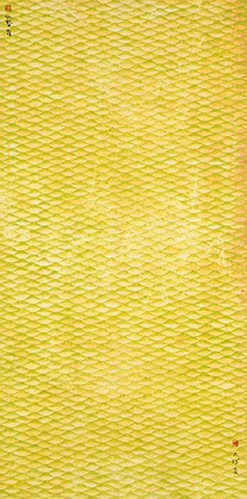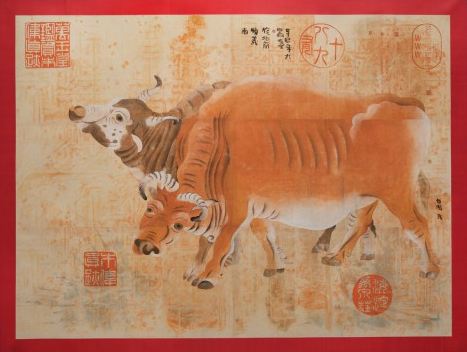|
wcma.williams.edu, March 2012
Modern & Contemporary Chinese Art
Zhu Wei (Chinese, b. 1966)
Great Water, No. 21, 2001
ink and color on paper
Gift of Red Rock Studio, Hong Kong, A Williams Alumnus
M.2007.20.26
Zhu Wei (Chinese, b. 1966)
China Diary, No. 52, 2001
ink and color on paper
Gift of Red Rock Studio, Hong Kong, A Williams Alumnus
M.2007.20.27
Text by Gao Shiming, Executive Dean of the School of Intermedia Art, China Academy of Art
Translated by Donald Maruyama, Williams College Class of 2012
Zhu Wei, born in Beijing in 1966, first studied in the Liberation Army’s Art Institute, then in the Beijing
Film Academy and the Chinese Art Research Institute. He is one of the few artists to use traditional
ink painting to interpret Chinese social realities. From 1993, Zhu Wei has continuously participated in
international exhibitions with these ink paintings.
While Zhu Wei’s works primarily consist of ink paintings, he has also created many sculptures and
engravings. His grasp of the reality of the lives of modern Chinese people is at the core of his artistic
endeavors. Zhu Wei is always able to unobtrusively transform a collective unconscious viewpoint into
his own unique perspective, weaving in and out across the boundaries between childhood dreams and
reality. His ink paintings have an intensely individualistic quality : his techniques, including the traditional
fine brushwork and heavy use of coloring, as well as the exquisite patient style, perhaps originated from
the strict training he received in the Liberation Army’s Art Institute. The composition of some of his works
is similar to that of a story board and approaches a film plot. For Zhu Wei, his paintings are a medium
through which he narrates his fables and stories, especially in his serial works. In terms of depicting
the human form, he has chosen the early Renaissance style with a slight absence of three-dimensional
shapes, which particularly suits traditional Chinese drawing habits. Through the use of painstaking
rendering and mottled skin texture, the artist represents the human form in a lightly carved style. The
self-deprecating inquiry and the familiar scent of the homely, the absurd, and the numbness - these are
all central aspects of the mood of Zhu Wei’s works.
His work:

Great Water, No. 21
Zhu Wei’s Great Water Series is comprised of twenty-five works; while the size and color of each painting
differs, they all utilize fish scale patterns as background, and are quite ornate. In the series, the richness
and the pursuit of subtle changes of the ancient “Clouds and Water Painting” are completely subverted.
Zhu Wei incorporates excerpts from the traditional “Clouds and Water Painting” and renders the coldest,
most mechanical replication. The scene is reminiscent of calico or cheap wall paper. This work resembles
a blueprint more than a painting. The artist’s desire is simply to flaunt a kind of attitude towards tradition
and an action of disenchantment.

China Diary, No. 52
The German artist Richter has stated, “Everything made since Duchamp has been a readymade, even
when hand-painted.” We should examine the color design of this piece through the lens of a “readymade”
item. As is commonly known “mimicry” is an important methodology of study in Chinese paintings.
Mimicry is not simply characterized by imitation but rather a response, a dialogue between contemporary
artists and ancient masters. However, the work created in 2001 called China Diary No. 52 is simply a
replication of the ancient painting style. Even the personal seal of the previous collectors of the original
piece to the traces of wear left by passing time has been impeccably duplicated.
Be that as it may, the painter after all is there for more than simple duplication. In the tradition of Chinese
painting, a creator should not cover too much of the empty space in the painting with his own seals, and
should leave room for the seals of future collectors and connoisseurs. Zhu Wei on the other hand has a
large set of different seals of his own, including even a seal carrying the address of his personal website.
The latter is a little joke defying tradition, but at the same time a mark of the information era. It is a type of
archaeology that faces the future, not without irony but real to its existence.
威廉姆斯大学美术馆网站wcma.williams.edu, 2012年3月
现当代中国艺术
撰文:高士明
英译:Donald Maruyama
此文为美国威廉大学美术馆(Williams College Museum of Art)藏品说明——编者注
朱伟(中国,1966年生)
大水二十一号,2001
水墨设色纸本
香港Red Rock工作室 一位威廉姆斯校友捐赠
M.2007.20.26
朱伟(中国,1966年生)
中国日记五十二号,2001
水墨设色纸本
香港Red Rock工作室 一位威廉姆斯校友捐赠
M.2007.20.27
撰稿人高士明为中国美术学院跨媒体艺术学院常务副院长,译者Donald Maruyama为威廉姆斯大学2012年学生。
朱伟1966年出生于北京,先后在解放军艺术学院、北京电影学院、中国艺术研究院就读。他是为数不多的使用传统的水墨画解释中国社会现实的艺术家之一 。从1993年起,朱伟已连续以水墨画参加了许多国际性的展览。
虽然他的创作以水墨画为主,他同时也创造了许多雕塑和版画。对现代中国人生活现实的把握是他的艺术的核心。朱伟总是能够以他自己独特的视角悄悄变换一种集体无意识的观点,自由地穿越童年梦幻与现实之间的界限。他的水墨画有一个强烈的个人主义的品质:他的技法,包括传统工笔重彩,以及精湛细腻的风格,也许是源于解放军艺术学院严格的训练。他的一些作品构图类似于故事板,达到电影情节的效果。朱伟的画是他讲述他的寓言和故事的媒介,尤其是在他的系列作品中。在描绘人物形象上,他选择了早期文艺复兴时期的风格,有轻微的三维效果,这特别适合中国传统的绘画习惯。通过使用悉心的渲染和斑驳的皮肤纹理,艺术家表现的人物形象具有微妙的雕刻风格。自嘲的疑虑和家常、荒谬、麻木的熟悉气味——这些都是朱伟作品意境的所有核心气氛。
他的作品:

《大水二十一号》
朱伟的大水系列是由二十五个作品组成,每幅画的尺寸和颜色不同,但它们都利用了鱼鳞图案为背景,相当华丽。在这一系列中,传统“云水图”的丰富性和对微妙变化的追求得到了彻底颠覆。朱伟摘取传统“云水图”的片段,并呈现出最冷静和最机械的复制。作品让人联想到白布或廉价的墙纸,更像蓝图而非绘画。艺术家的意图仅仅是标榜一种对传统的态度,和一种觉醒的行动。

《中国日记五十二号》
德国艺术家里希特曾说过,“自杜尚以降一切皆现成,甚至连手绘画作也如此。”我们应该通过“现成”作品这块透镜来研究这件作品的色彩设计。众所周知,“摹仿”是在中国画领域一个重要的学习方法。摹仿不是简单的摹仿,而是一种当代艺术家与古代大师之间的对话,是一种响应。然而,在2001年创作的这件《中国日记52号》呈现出简单的复制古代的绘画风格,即使是传递时间所留痕迹的原来古代收藏家的一块磨损的私章也已被无可挑剔的复制。
尽管如此,画家毕竟不可能简单的重复。在传统中国画中,创作者不应用自己的印章占据太多空间,应该留白给未来的收藏家和鉴赏家钤印。可是相反,朱伟却在空白处印满硕大的个人印章,甚至包括一枚刻着他个人网址的印章。后者是一个小小的不畏传统的玩笑,但也是一个信息化时代的标志。它是一种面向未来的考古学,不无讽刺,却反映了真实的存在。
|